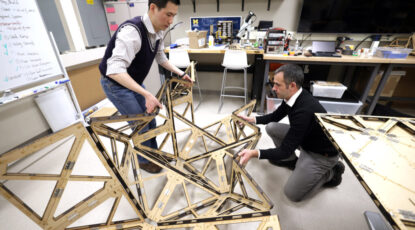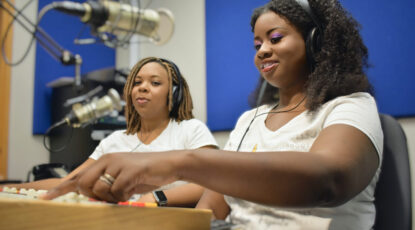-
Bridge in a box: Unlocking origami’s power to produce load-bearing structures
For the first time, load-bearing structures like bridges and shelters can be made with origami modules — versatile components that can fold compactly and adapt into different shapes. It’s an advance that could enable communities to quickly rebuild facilities and systems damaged or destroyed during natural disasters, or allow for construction in places that were previously considered impractical, including outer space.
-
Cracking in lithium-ion batteries speeds up electric vehicle charging
Rather than being solely detrimental, cracks in the positive electrode of lithium-ion batteries reduce battery charge time, a U-M research team reports. This runs counter to the view of many manufacturers, who try to minimize cracking because it decreases battery longevity.
-
Largest U.S. investment in particle self-assembly seeks to deliver on nanotechnology’s promise
With applications in transportation, energy, health care and more, the center includes African universities and creates opportunities for overlooked talent in the U.S.
-
AI could run a million microbial experiments per year
An artificial intelligence system enables robots to conduct autonomous scientific experiments — as many as 10,000 per day — potentially driving a drastic leap forward in the pace of discovery in areas from medicine to agriculture to environmental science.
-
Advancing chips for the auto sector is the goal of new Michigan-based initiative
The STAR initiative is a public-private partnership that will focus on developing the talent base and infrastructure necessary to accelerate advanced semiconductor applications for electrification and autonomous mobility.
-
From Cuba to chemical engineering: ‘I’m supposed to be here’
Ph.D. student José Carlos Díaz first merged his knack for engineering and science by repairing microscopes for use in his sixth-grade class. He was 11 years old. He’s now an ion-diffusion researcher at one of the top chemical engineering programs in the U.S.
-
Tracking ocean microplastics from space
Harmful microplastics — tiny flecks that can ride ocean currents for thousands of miles — are extremely difficult to track and clean up. But, it turns out these same microplastics tag along with soapy or oily residue, which satellites are great at spotting.
-
Not hidden but modern
U-M’s first Black woman to graduate with a PhD in computer science and engineering is driving change within the University of Florida and scaling her influence with a podcast.
-
Stars in our eyes
Astronomy consistently garners more public support than the earthbound sciences. Could it be those fancy telescopes?









